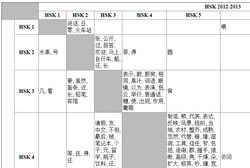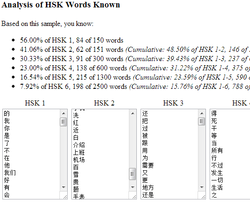[Update 2nd December 2013: I added links to an HSK-aware dictionary to all the characters below!]
Once you have learned a few hundred Chinese words, you start to come across sentences where you recognise all of the characters but have no idea what the actual meaning of the sentence is. This is because there are many 'patterns' in Chinese where a set arrangement of words has a specific meaning.
Common Chinese Patterns 330 is a fantastic resource for picking up subtle grammar points that are easily missed. This book will help you to improve your grammar at any level, through clear examples. If you are studying for one of the HSK levels 1-5, you may not want to just work through the book from start to finish however, as you will be introduced to patterns that use characters above your level. The hanzi in the chapter list were coloured by HSK level using this script and then grouped by hand. The colours for HSK levels 1-6 are in the order that they appear in a rainbow: red, orange, yellow, green, blue, violet.
The following list splits up the 'chapter' titles (patterns) by HSK level. Note that many of the patterns will not be encountered at the levels shown even though all of the characters are known at that level. In the long run I don't think it hurts to be exposed to these patterns early on though, and reinforce the meanings of the characters and words that make them up.
Another couple of caveats: The example sentences for each pattern ignore HSK levels of course. It would be a good exercise to create some new example sentences for each pattern that only use characters from the HSK level in which it appears - if I get around to doing this I'll share the results (Feel free to send me any sentences that you create). Also some patterns have alternative words, and the alternatives may have different HSK levels. I have grouped these patterns at the higher of the two levels, to save studying the pattern twice.
Once you have learned a few hundred Chinese words, you start to come across sentences where you recognise all of the characters but have no idea what the actual meaning of the sentence is. This is because there are many 'patterns' in Chinese where a set arrangement of words has a specific meaning.
Common Chinese Patterns 330 is a fantastic resource for picking up subtle grammar points that are easily missed. This book will help you to improve your grammar at any level, through clear examples. If you are studying for one of the HSK levels 1-5, you may not want to just work through the book from start to finish however, as you will be introduced to patterns that use characters above your level. The hanzi in the chapter list were coloured by HSK level using this script and then grouped by hand. The colours for HSK levels 1-6 are in the order that they appear in a rainbow: red, orange, yellow, green, blue, violet.
The following list splits up the 'chapter' titles (patterns) by HSK level. Note that many of the patterns will not be encountered at the levels shown even though all of the characters are known at that level. In the long run I don't think it hurts to be exposed to these patterns early on though, and reinforce the meanings of the characters and words that make them up.
Another couple of caveats: The example sentences for each pattern ignore HSK levels of course. It would be a good exercise to create some new example sentences for each pattern that only use characters from the HSK level in which it appears - if I get around to doing this I'll share the results (Feel free to send me any sentences that you create). Also some patterns have alternative words, and the alternatives may have different HSK levels. I have grouped these patterns at the higher of the two levels, to save studying the pattern twice.


 RSS Feed
RSS Feed